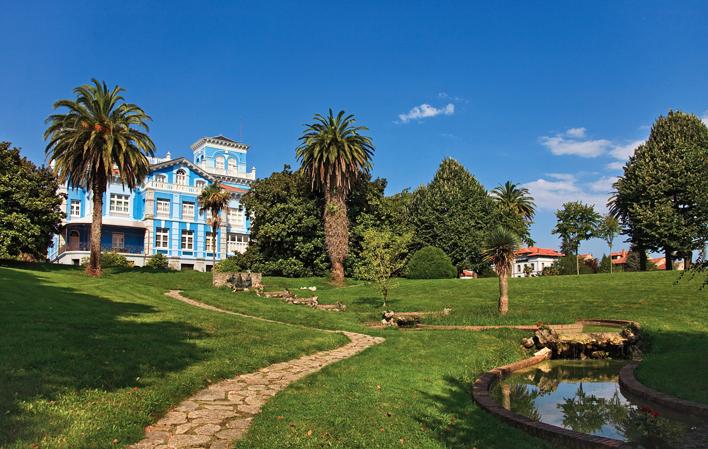
American soul in Ribadesella, Llanes and Colombres
- Address Ribadesella, Llanes and Ribadedeva Eastern Asturias
- Distance Distance: 150,8 kms
- Difficulty Difficulty: Short
- Cars Cars: 5 days
- Start point Start point: Ribadesella
- Route type Route type: car
- Layout of the route Layout of the route: Download kml
If the east of Asturias has a great Indian influence, it is undoubtedly in towns such as Ribadesella, Llanes and Colombres where it is most notable.
Info
The three coastal municipalities of eastern Asturias have their administrative centres in towns of singular beauty, marked by the money and architecture that the emigrants who succeeded in America brought back home. These Indianos, who in many cases only returned as holidaymakers, are still present in the main buildings of Ribadesella, Llanes and Colombres, as well as in a multitude of small towns.
Route
Ribadesella/Ribeseya - Cuevas del Agua - Ribadesella/Ribeseya 15,1
Day 1: Ribadesella/Ribeseya grows around the estuary into which the river Sella flows. A long walk along the beach, the port, the Ermita de la Guía hermitage and the historic quarter reveal its stately character. On this first foray, you will come across the first "Indiano" mansions in the vicinity of the beach of Santa María or the Museum of the Territory of Ribadesella, housed in an old "Indiano" school dating from 1900. Next to the port, six ceramic murals reproduce vignettes by the cartoonist Antonio Mingote that trace a historical route. It is worth visiting the old quarter from the Travesía Oscura to see buildings such as the Casa de la Cueva or the Palacio de la Familia de Cutre. On the other side of the estuary, the Tito Bustillo Cave is a UNESCO World Heritage Site. Visits are very restricted and must be closed in advance. In any case, the modern Cave Art Centre allows visitors to discover this age-old heritage. You can also discover the Cuevona de Cuevas, 4 kilometres away, next to Tito Bustillo. Crossing the cave is the only access to the village.
Ribadesella/Ribeseya - Vega beach - Ribadesella/Ribeseya 16,5
Day 2: Outside the town centre of Ribadesella/Ribeseya there are many activities on offer, from horse riding to surfing, mountain biking or canoeing on the Sella. You can also go hiking. The Cuerres route starts in the town, which is originally seven kilometres long and takes in the Guadamía estuary and its surroundings, but also links up with the Pilgrims' Route to Santiago de Compostela. Or you can complete the Los Molinos route. It is a circular route of almost nine kilometres and has an optional climb to Pico Moru. It is worth taking the car to get to Vega beach along the N-632 as far as the turn-off to the beach two kilometres beyond San Esteban de Leces. This beach, one of the largest in Asturias, and the area around Entrepeñes have been declared a Natural Monument.
Ribadesella/Ribeseya - Llanes 72,3
Day 3: After Ribadesella, Llanes. In this council you can take the so-called Indiana Route by car. This is an itinerary through different villages, which connects the main examples of the architecture erected by the Asturians who emigrated to America. Most of the buildings are privately owned and can only be seen from the outside. The journey can begin in Nueva, for which we take the AS-263 from Ribadesella/Ribeseya, where the attraction lies in the architectural ensemble, and in Naves, to discover its square. In Valmori is the Chalet of the widow of Bartolomé González, as well as the fountain and the washing place, and in Porrúa, the Ethnographic Museum, which is a donation from the Indians. In La Pereda, the chapel, the bowling alley and the castañedo. In Vidiago, there are some old schools and chalets with unique modernist attics. In Pendueles are the Casona de Verines and the Palace of Santa Engracia or that of the Mendoza Cortina family. And La Borbolla is an ideal place to contemplate its square and mansions. Heading towards Llanes, we will pass through La Arquera and its unique building, the school. We will turn off to Po, where we will find the Casona de la Jabariega (modernist from 1905), the Chalet of Concha Garaña, the church, the bowling alley and the casino. We will end the day in Llanes.
Llanes - Toró Beach 24,2
Day 4: The proposal for the fourth day is the town of Llanes, which allows you to enjoy it on foot and take a break from the car. The traveller can explore the historic-artistic centre, which includes everything from the medieval walls to numerous examples of civil and religious architecture. Apart from the historic centre, there are examples of the Indianos, such as La Casa de los Leones, Villa Concepción, the Palace of the Marquesa de Argüelles, Villa Parres and the Casa de los Junco, the casino, the Avenida de La Paz... Next to the port, the immense Cubos de la Memoria by the Basque sculptor Agustín Ibarrola. The coastal promenade allows you to walk from the most urban part of the city to Toró beach, a journey that takes barely an hour.
Llanes - Colombres - Bustio 23,8
Day 5: The council of Ribadedeva brings together the last Indian villages of the East. Its capital has been an Asset of Cultural Interest (BIC) since August 2013, due to its high concentration of Indian architecture. Perhaps the best known is the Quinta Guadalupe, home to the Archivo de Indianos, but you can also visit the cemetery, the square and the town hall. The town of Villanueva also contains more examples of this type of architecture. You should not leave the council without visiting La Franca beach, the El Pindal Cave, a UNESCO World Heritage Site, and the port of Bustio, the most easterly in the whole region.
Map
Itinerary
Ribadesella/Ribeseya - Po - Valmori - Po - Vidiago - Pendueles - Borbolla - Llanes - Colombres - Villanueva




